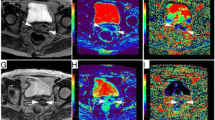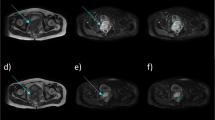Abstract
Objectives
To investigate if intravoxel incoherent motion (IVIM) MR imaging can predict the tumour-stroma ratio (TSR) in patients with early cervical carcinoma.
Methods
Fifty-four patients with early cervical carcinoma were prospectively enrolled into this study. All patients underwent IVIM imaging and parameters including D, D* and f value were measured. The tumours were classified into stroma-rich and stroma-poor group according to TSR, and comparisons of IVIM parameters between two groups were performed. The relationships between IVIM parameters and TSR were analysed by using a multivariate multi-regression analysis.
Results
D and f values were significantly lower in stroma-poor tumours than in stroma-rich tumours (p=0.02, 0.04), while the difference in D* value between two groups didn't achieve statistical significance (p=0.09). The areas under ROC curves of D and f values in discriminating stroma-rich and stroma-poor tumours were 0.835 (95%CI=0.616~0.905) and 0.686 (95%CI=0.575~0.798). In multiple linear regression analysis, D value, pathologic type, histologic grade, tumour size and f value were independently correlated with TSR of cervical carcinoma.
Conclusions
D and f values are independently correlated with TSR of cervical carcinoma and have the potential for quantitative measurement of TSR.
Key Points
• TSR is a recognized independent prognostic factor in many solid tumours.
• D and f values measured by IVIM MRI are independently correlated with TSR while D* is not.
• IVIM offers the potential to predict TSR.




Similar content being viewed by others
References
Mesker WE, Junggeburt JM, Szuhai K et al (2007) The carcinoma-stromal ratio of colon carcinoma is an independent factor for survival compared to lymph node status and tumour stage. Cell Oncol 29:387–398
Liu J, Liu J, Li J et al (2014) tumour-stroma ratio is an independent predictor for survival in early cervical carcinoma. Gynecol Oncol 132:81–86
de Kruijf EM, van Nes JG, van de Velde CJ et al (2011) tumour-stroma ratio in the primary tumour is a prognostic factor in early breast cancer patients, especially in triple-negative carcinoma patients. Breast Cancer Res Treat 125:687–696
Ahn S, Cho J, Sung J et al (2012) The prognostic significance of tumour-associated stroma in invasive breast carcinoma. Tumour Biol 33:1573–1580
Gremonprez F, Descamps B, Izmer A et al (2015) Pretreatment with VEGF(R)-inhibitors reduces interstitial fluid pressure, increases intraperitoneal chemotherapy drug penetration, and impedes tumour growth in a mouse colorectal carcinomatosis model. Oncotarget 6:29889–29900
Wu J, Liang C, Chen M, Su W (2016) Association between tumour-stroma ratio and prognosis in solid tumour patients: a systematic review and meta-analysis. Oncotarget 7:68954–68965
Zhang R, Song W, Wang K, Zou S (2017) Tumour-stroma ratio(TSR) as a potential novel predictor of prognosis in digestive system cancers: A meta-analysis. Clin Chim Acta 472:64–68
Roeke T, Sobral-Leite M, Dekker TJA (2017) The prognostic value of the tumour-stroma ratio in primary operable invasive cancer of the breast: a validation study. Breast Cancer Res Treat. https://doi.org/10.1007/s10549-017-4445-8
Zhang XL, Jiang C, Zhang ZX, Liu F, Zhang F, Cheng YF (2014) The tumour-stroma ratio is an independent predictor for survival in nasopharyngeal cancer. Oncol Res Treat 37:480–484
Ko ES, Han BK, Kim RB et al (2014) Apparent diffusion coefficient in estrogen receptor-positive invasive ductal breast carcinoma: correlations with tumour-stroma ratio. Radiology 271:30–37
Che S, Zhao X, Ou Y et al (2016) Role of the intravoxel incoherent motion diffusion weighted imaging in the pre-treatment prediction and early response monitoring to neoadjuvant chemotherapy in locally advanced breast cancer. Medicine (Baltimore) 95:e2420–e2432
Le Bihan D, Breton E, Lallemand D et al (1986) MR imaging of intravoxel incoherent motions: application to diffusion and perfusion in neurologic disorders. Radiology 161:401–407
Zhang G, Wang S, Wen D et al (2016) Comparison of non-Gaussian and Gaussian diffusion models of diffusion weighted imaging of rectal cancer at 3.0 T MRI. Sci Rep 6:38782–38791
Klauss M, Mayer P, Maier-Hein K et al (2016) IVIM-diffusion-MRI for the differentiation of solid benign and malignant hypervascular liver lesions-evaluation with two different MR scanners. Eur J Radiol 85:1289–1294
Lee YJ, Kim SH, Kang BJ et al (2017) Intravoxel incoherent motion (IVIM)-derived parameters in diffusion-weighted MRI: associations with prognostic factors in invasive ductal carcinoma. J Magn Reson Imaging 45:1394–1406
Ma C, Li Y, Wang L et al (2017) Intravoxel incoherent motion DWI of the pancreatic adenocarcinomas: monoexponential and biexponential apparent diffusion parameters and histopathological correlations. Cancer Imaging 28:12–21
Xu XQ, Choi YJ, Sung YS et al (2016) Intravoxel incoherent motion MR imaging in the head and neck: correlation with dynamic contrast-enhanced MR imaging and diffusion-weighted imaging. Korean J Radiol 17:641–649
Caldas-Magalhaes J, Kasperts N, Kooij N et al (2012) Validation of imaging with pathology in laryngeal cancer: accuracy of the registration methodology. Int J Radiat Oncol Biol Phys 82:e289–e298
Odida M, Schmauz R (1996) Classification and grading of squamous cell carcinoma of the cervix. East Afr Med J 73:S9–S10
Lin L (1989) A concordance correlation coefficient to evaluate reproducibility. Biometrics. 45:255–268
Lemke A, Stieltjes B, Schad LR, Laun FB (2011) Toward an optimal distribution of b values for intravoxel incoherent motion imaging. Magn Reson Imaging 29:766–776
Correia MM, Carpenter TA, Williams GB (2009) Looking for the optimal DTI acquisition scheme given a maximum scan time: are more b-values a waste of time? Magn Reson Imaging 27:163–175
Wu WC, Yang SC, Chen YF, Tseng HM, My PC (2017) Simultaneous assessment of cerebral blood volume and diffusion heterogeneity using hybrid IVIM and DK MR imaging: initial experience with brain tumours. Eur Radiol 27:306–314
Driessen JP, Caldas-Magalhaes J, Janssen LM et al (2014) Diffusion-weighted MR imaging in laryngeal and hypopharyngeal carcinoma: association between apparent diffusion coefficient and histologic findings. Radiology 272:456–463
Lee EY, Yu X, Chu MM et al (2014) Perfusion and diffusion characteristics of cervical cancer based on intraxovel incoherent motion MR imaging-a pilot study. Eur Radiol 24:1506–1513
Zhu L, Zhu L, Shi H et al (2016) Evaluating early response of cervical cancer under concurrent chemo-radiotherapy by intravoxel incoherent motion MR imaging. BMC Cancer 16:79–87
Wang YC, Hu S, Hu XM et al (2015) Intravoxel incoherent motion magnetic resonance imaging for diagnosis of cervical cancer and evaluation of response of uterine cervical cancer to radiochemotherapy: a pilot study. Oncology and Translational Medicine 1:P164–P170
Winfield JM, Orton MR, Collins DJ et al (2017) Separation of type and grade in cervical tumours using non-mono-exponential models of diffusion-weighted MRI. Eur Radiol 27:627–636
Aoyagi T, Shuto K, Okazumi S et al (2012) Apparent diffusion coefficient correlation with oesophageal tumour stroma and angiogenesis. Eur Radiol 22:1172–1177
Partridge SC, Mullins CD, Kurland BF et al (2010) Apparent diffusion coefficient values for discriminating benign and malignant breast MRI lesions: effects of lesion type and size. AJR Am J Roentgenol 194:1664–1673
Liu Y, Bai R, Sun H et al (2009) Diffusion weighted imaging in predicting and monitoring the response of uterine cervical cancer to combined chemoradiation. Clinical Radiology 64:1067–1074
Kuang F, Ren J, Zhong Q et al (2013) The value of apparent diffusion coefficient in the assessment of cervical cancer. Eur Radiol 23:1050–1058
Barbieri S, Donati OF, Froehlich JM, Thoeny HC (2016) Impact of the calculation algorithm on biexponential fitting of diffusion-weighted MRI in upper abdominal organs. Magn Reson Med 75:2175–2184
Jerome NP, Miyazaki K, Collins DJ et al (2017) Repeatability of derived parameters from histograms following non-Gaussian diffusion modelling of diffusion-weighted imaging in a paediatric oncological cohort. Eur Radiol 27:345–353
Lin M, Yu X, Chen Y et al (2017) Contribution of mono-exponential, bi-exponential and stretched exponential model-based diffusion-weighted MR imaging in the diagnosis and differentiation of uterine cervical carcinoma. Eur Radiol 27:2400–2410
Verma S, Sarkar S, Young J et al (2016) Evaluation of the impact of computed high b-value diffusion-weighted imaging on prostate cancer detection. Abdom Radiol (NY) 41:934–945
Becker AS, Perucho JA, Wurnig MC et al (2017) Assessment of cervical cancer with a parameter-free intravoxel incoherent motion imaging algorithm. Korean J Radiol 18:510–518
Funding
The authors state that this work has not received any funding.
Author information
Authors and Affiliations
Corresponding author
Ethics declarations
Guarantor
The scientific guarantor of this publication is Li Xiang Sheng, M.D. and Yu Tao, M.D.
Conflict of interest
The authors of this manuscript declare no relationships with any companies, whose products or services may be related to the subject matter of the article.
Statistics and biometry
No complex statistical methods were necessary for this paper.
Informed consent
Written informed consent was obtained from all subjects (patients) in this study.
Ethical approval
Institutional Review Board approval was obtained.
Methodology
• Prospective
• diagnostic study / observational
• performed at one institution
Additional information
Xiangsheng Li and Ping Wang equally contributed to the work and should be regarded as co-first authors.
Rights and permissions
About this article
Cite this article
Li, X., Wang, P., Li, D. et al. Intravoxel incoherent motion MR imaging of early cervical carcinoma: correlation between imaging parameters and tumor-stroma ratio. Eur Radiol 28, 1875–1883 (2018). https://doi.org/10.1007/s00330-017-5183-3
Received:
Revised:
Accepted:
Published:
Issue Date:
DOI: https://doi.org/10.1007/s00330-017-5183-3




